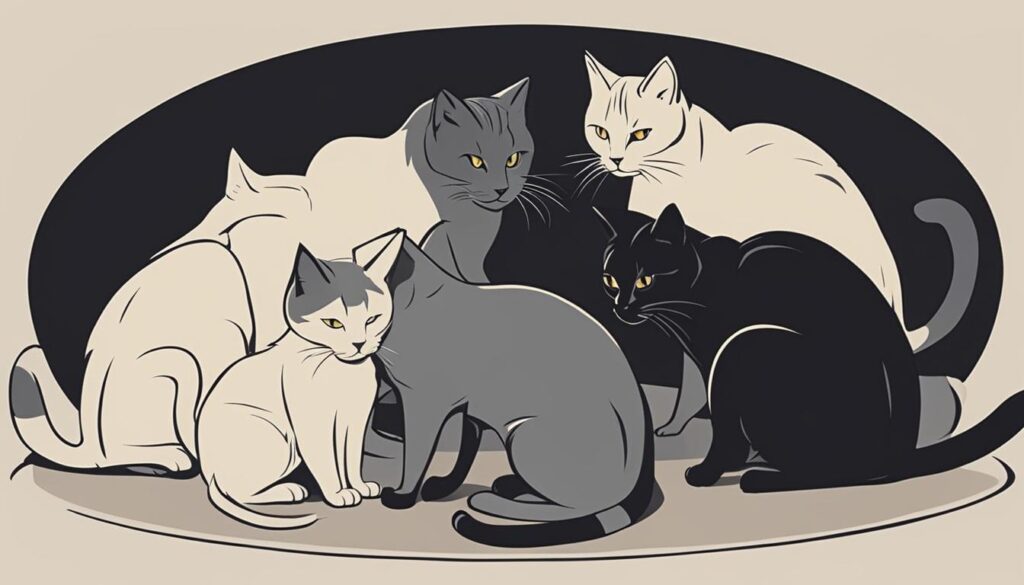Why Do Cats Shake Their Tails? Unveil the Mystery
Have you ever wondered why cats shake their tails? It’s a common behavior that often leaves cat owners puzzled. Cats use their tails as a vital tool to express various emotions, intentions, and needs. Tail shaking can indicate excitement, anticipation, or agitation. It can also serve as a form of communication between cats, as they exchange vital information about their intentions and willingness to interact. But what exactly is the reason behind this intriguing behavior?
Cat tail shaking behavior can have multiple reasons, and understanding it can help decode your feline friend’s messages accurately. In this article, we will delve into the fascinating world of cat tail shaking, exploring the different factors that contribute to this behavior. From communication to emotional expressions, we will uncover the various meanings behind those captivating tail movements.
Key Takeaways:
- Cats shake their tails to express various emotions, intentions, and needs.
- Tail shaking is a form of communication between cats, conveying information about their intentions and willingness to interact.
- Understanding cat tail movements requires considering the context and observing other behaviors exhibited by the cat.
- Cat tail shaking can be an expression of excitement, anticipation, or agitation.
- It is important to observe the overall body language and situation before interpreting a cat’s tail shaking accurately.
Understanding Feline Tail Communication
Cats are masters of non-verbal communication, and their tails play a significant role in expressing their emotions and intentions. By paying attention to a cat’s tail movements, we can gain valuable insights into their state of mind. Tail shaking is just one aspect of feline tail communication that requires careful observation and interpretation.
When a cat’s tail is held high and upright, it often signifies confidence and a friendly disposition. This elevated position indicates that the cat is approachable and open to interaction. On the other hand, a lowered or tucked tail suggests fear, submission, or unease. Cats exhibit this tail position when they feel threatened or anxious.
Understanding cat tail movements goes beyond the tail’s position. It also involves observing the tail’s movement and shaking patterns. Tail shaking can occur for various reasons, and its meaning may depend on the context and accompanying behaviors. It is important to consider the overall body language of the cat and any vocalizations they may make.
In feline tail communication, tail shaking is often associated with excitement, anticipation, or agitation. Cats may vigorously shake their tails when engaged in play or eagerly awaiting a meal. This energetic movement of the tail can be an expression of their heightened emotions and enthusiastic energy.
Quote: “Observing a cat’s tail shaking can provide valuable insights into their emotional state and intentions. However, it is essential to consider the context and observe the cat’s overall behavior to accurately interpret their communication.”
To better understand a cat’s tail shaking behavior, it is important to observe other accompanying behaviors. Pay attention to their ear position, facial expressions, and any vocalizations they may make. By taking these elements into account, you can paint a more complete picture of their communication and gain a deeper understanding of your feline companion’s needs and emotions.
Remember that every cat is unique, and their tail movements may vary. Take the time to familiarize yourself with your cat’s individual tail communication style. By doing so, you can strengthen your bond with them and respond to their needs more effectively.
To summarize, feline tail communication is a fascinating aspect of cat behavior. Tail shaking is just one way cats use their tails to express themselves. By observing a cat’s tail position, movement, and shaking patterns, we can decipher their emotional state and intentions. Remember to consider the context and observe other accompanying behaviors to ensure accurate interpretation.

Understanding the intricacies of feline tail communication can be challenging but rewarding. By decoding their tail language, you can develop a deeper connection with your cat and respond to their needs more effectively.
| Tail Position | Meaning |
|---|---|
| High and Upright | Confidence, friendliness |
| Lowered or Tucked | Fear, submission, unease |
| Shaking and Vibrating | Excitement, anticipation, agitation |
Emotional Expressions through Tail Shaking
Cat body language is a fascinating aspect of feline behavior, and tail shaking serves as an important means of emotional expression. When a cat’s tail shakes rapidly, it can often be a sign of their excitement, anticipation, or agitation. This behavior is commonly observed when cats are engaged in play, eagerly awaiting their meal, or experiencing intense emotions.
By paying close attention to the context and accompanying behaviors, we can gain valuable insights into a cat’s state of mind. However, it is important to note that tail shaking alone may not provide enough information to accurately decipher its meaning. To fully understand a cat’s emotional state, it is essential to consider their overall body language and the specific situation at hand.
Just like humans, cats have a unique way of expressing their feelings. Tail shaking is one of the many ways cats communicate with us and other animals around them. By observing their tails, we can become more attuned to their needs, desires, and emotions.
“A rapidly shaking tail may indicate excitement, anticipation, or agitation.”
While tail shaking is an intriguing behavior, it is essential to interpret it in conjunction with other cues. For example, if a cat’s tail is also puffed up, their body tense, and their ears flat against their head, it could indicate fear or aggression rather than excitement. Therefore, it is crucial to consider the bigger picture and look for additional signs before drawing conclusions about a cat’s emotional state.
To further understand the significance of cat tail shaking, let’s consider a practical example. Imagine your cat is playfully chasing a toy, and her tail starts shaking rapidly as she pounces on it. This tail behavior, accompanied by her playful body language and energetic movements, signals her excitement and enjoyment of the game.
Significance of Cat Tail Shaking
Understanding the significance of cat tail shaking can deepen our connection with our feline companions. It allows us to recognize when they are feeling enthusiastic, anxious, or eager. By paying attention to their tail movements, we can respond appropriately to their emotional needs and ensure their well-being.
When you notice your cat’s tail shaking, take a moment to evaluate the situation and consider their overall body language. This holistic approach to understanding cat communication will help strengthen the bond between you and your furry friend.

| Emotion | Signs |
|---|---|
| Excitement | Rapid tail shaking accompanied by energetic movements. |
| Anticipation | Tail quivering or vibrating with a slight wag. |
| Agitation | Fast, forceful tail shaking with the body tense. |
Medical Conditions and Tail Shaking
While tail shaking is often harmless and part of normal feline behavior, in some cases, it can be indicative of underlying medical conditions. Certain neurological disorders can cause involuntary tail tremors or spasms in cats. Conditions such as feline hyperesthesia syndrome or cerebellar hypoplasia may result in abnormal tail movements.
If you notice persistent or severe tail shaking accompanied by other unusual symptoms, it is advisable to consult a veterinarian. Injury or pain can also cause a cat’s tail to shake, so it is essential to seek veterinary attention if your cat displays signs of discomfort.
In some cases, tail shaking can be a symptom of underlying health issues. Your veterinarian will examine your cat, potentially perform diagnostic tests, and develop a treatment plan based on their findings. Timely intervention can help alleviate any pain or discomfort and ensure your cat’s well-being.
“If you notice persistent or severe tail shaking accompanied by other unusual symptoms, it is advisable to consult a veterinarian.”
Trust your instincts as a pet owner – if you feel that something is not right, it is always better to seek professional guidance. By addressing any potential medical concerns, you can help your furry companion lead a happy and healthy life.
The Role of Veterinarians in Decoding Cat Tail Shaking
Veterinarians play a crucial role in understanding and diagnosing the causes of cat tail shaking. Their expertise allows them to evaluate the full picture, considering the cat’s medical history, physical examination, and any accompanying symptoms. By working closely with your veterinarian, you can gain a deeper understanding of your cat’s condition and implement appropriate interventions.
| Medical Conditions | Symptoms | Treatment |
|---|---|---|
| Feline Hyperesthesia Syndrome | – Tail twitching or shaking – Excessive grooming or self-mutilation – Aggression or irritability – Dilated pupils – Increased vocalization – Skin rippling or muscle spasms |
– Medication to manage symptoms – Environmental modifications to reduce stress |
| Cerebellar Hypoplasia | – Involuntary movements, including tail shaking – Lack of coordination – Tremors – Difficulty walking or jumping – Abnormal eye movements |
– Supportive care to manage symptoms – Adaptive strategies to improve quality of life |
Note: The table above provides examples of medical conditions that can cause tail shaking in cats. It is essential to consult a veterinarian for an accurate diagnosis and appropriate treatment.
Interpreting Tail Shaking in Cats
When trying to understand why a cat shakes its tail, it’s essential to consider the context and observe other behaviors exhibited by the cat. Tail shaking alone may not provide enough information to accurately decipher its meaning. To gain a deeper understanding, pay attention to the cat’s overall body language, vocalizations, and the situation at hand.
When a cat shakes its tail during play or interaction, it is generally a positive sign. It indicates their excitement, enjoyment, and willingness to engage. The tail shaking adds an extra layer of excitement to the activity, giving you a clear signal that your cat is fully involved in the moment.
However, tail shaking accompanied by aggression or fear should be approached with caution. If you notice your cat exhibiting aggressive behavior with tail shaking, it may indicate a potential threat or discomfort. Take a step back and assess the situation to prevent any potential harm to yourself or other animals.
If you’re unsure about the reasons behind your cat’s tail shaking or if it is accompanied by other concerning symptoms, it is always wise to consult a veterinarian. They can provide professional insights, evaluate your cat’s overall health, and rule out any potential medical conditions that may be causing the tail shaking.
Key Points:
- Interpreting tail shaking in cats requires considering the context and observing other behaviors.
- Tail shaking during play or interaction is generally a positive sign of excitement and engagement.
- Tail shaking accompanied by aggression or fear should be approached with caution.
- If unsure or concerned, consult a veterinarian for professional advice.
By paying close attention to your cat’s tail shaking behavior and understanding the accompanying cues, you can deepen your bond with your feline companion and ensure their well-being.
Conclusion
Cats are fascinating creatures with a complex system of communication. Their tails play a crucial role in expressing their emotions, intentions, and needs. Understanding cat tail movements is essential for decoding their behavior and deepening our connection with them.
By paying attention to the context and observing other behaviors, we can gain valuable insights into the meaning behind a cat’s tail shaking. A rapidly shaking tail may indicate excitement, anticipation, or agitation, while a lowered or tucked tail suggests fear, submission, or unease. However, it’s crucial to consider the overall body language of the cat to accurately interpret its emotional state and intentions.
While tail shaking is often a normal part of feline behavior, it’s important to be aware of potential underlying medical conditions. In some cases, persistent or severe tail shaking accompanied by other unusual symptoms could indicate neurological disorders or injury. If you notice any concerning signs, it’s advisable to consult a veterinarian to ensure your cat’s well-being.
Decoding cat tail shaking and understanding cat tail movements is an ongoing process that requires careful observation and consideration. By becoming familiar with their unique language, we can foster a deeper understanding and stronger bond with our feline companions.
FAQ
Why do cats shake their tails?
Cats shake their tails to express various emotions, intentions, and needs. Tail shaking can indicate excitement, anticipation, or agitation, and can also serve as a form of communication between cats. It may also be related to hunting or play behavior.
What does tail shaking in cats mean?
Tail shaking in cats can have different meanings depending on the context. It can signify excitement, anticipation, or agitation. However, it is important to also consider other body language and behaviors to accurately interpret a cat’s tail shaking.
How can I understand a cat’s tail movements?
By observing the position and movement of a cat’s tail, you can decipher their emotional state and intentions. A high, upright tail often indicates confidence and friendliness, while a lowered or tucked tail suggests fear or unease. Tail shaking is just one aspect of feline tail communication.
What is the significance of cat tail shaking?
Cat tail shaking is a way for cats to express their emotions and moods. It can indicate excitement, anticipation, or agitation. By paying attention to the context and accompanying behaviors, you can gain valuable insights into a cat’s state of mind.
Can tail shaking in cats be a sign of a medical condition?
While tail shaking is often a normal behavior, it can also be indicative of underlying medical conditions. Certain neurological disorders or injuries can cause involuntary tail tremors or spasms in cats. If you notice persistent or severe tail shaking accompanied by other unusual symptoms, it is advisable to consult a veterinarian.
How can I interpret tail shaking in cats?
Interpreting tail shaking requires considering the context and observing other behaviors exhibited by the cat. Tail shaking during play or interaction is generally a positive sign, while shaking accompanied by aggression or fear should be approached with caution. If you’re unsure about the reasons behind your cat’s tail shaking or if it is accompanied by other concerning symptoms, it is always wise to consult a veterinarian for guidance.

